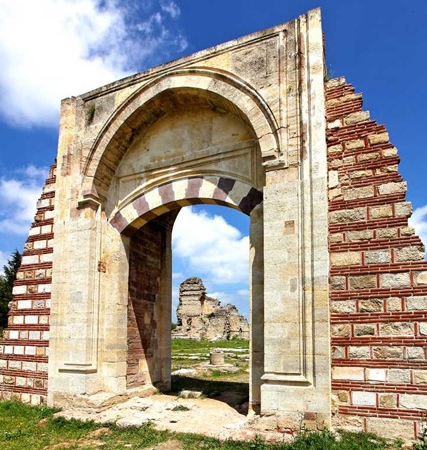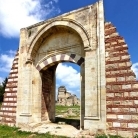The construction of the palace, which was built on an area of 300-355.000 square metres on the banks of the Tunca River in the north of the city, started in 1450 during the reign of Murat II. The construction of the palace, which stopped for a while upon the death of the ruler, was completed by Fatih Sultan Mehmet in 1475. During the reigns of Suleiman the Magnificent, Ahmet I, Mehmet the Hunter, Ahmet II, Ahmet III, the palace was constantly repaired and new buildings were added. After Ahmet III went to Istanbul in 1718, no sultan came to Edirne until Mustafa III in 1768, and this half-century period was the beginning of the destruction. The destruction process continued with the great earthquake in 1752 and the fire in 1776. In 1827, a part of the palace was repaired during the reign of Mahmut II. In 1829, the Russians who occupied Edirne used the palace as a camp and caused great damage. Many buildings were saved during the period of repair which started in 1868 with Governor Hurşit Pasha and continued until the governorship of Hacı İzzet Pasha in 1873.
During the Russian War of 1876-77, due to the approach of the enemy to the city, Governor Cemil Pasha and Ahmet Eyüp Pasha, the commander of Edirne, could not come to an agreement and the ammunition piled up around Bab'üs Sa'âde was exploded and many structures of the palace were destroyed as a result of the explosions that lasted for three days. After that, looting started and the remains of the palace were used in other buildings.
Cihannüma Pavilion (Taht-ı Hümayun) built by Fatih Sultan Mehmet constitutes the main structure of the palace. It consists of the Has room, the room of sevens, the sancak-ı şerif apartment, the library-i hümayun (palace library and the sancak-ı şerif masjid and apartments. To the south of the Cihannüma Pavilion, the apartments of Mehmet IV (Avcı), Mustafa II and Ahmet III were built adjacent to each other. Following these sultan's apartments, the Valide Sultan, the first, second, third and fourth women, princes, concubines, apartments for concubines, apartments for guards, patients' ward, aghas' apartments and the Arz Chamber to the west of the Cihannüma Pavilion formed the integrity of the palace. In front of the Arz Chamber is the Bab'üs Sa'ade (White Aghas Gate).
The construction of the Edirne New Palace, which started during the reign of Murat II, continued over time. Beyazıt II had the Tunca bed paved with stones and high retaining walls built on the sides. During the reign of Suleiman the Magnificent and Mimar Sinan, the Chief Architect, the Edirne Palace entered a second period of construction. During this period, the palace was re-planned, its topography was organized and water problems were solved. Mimar Sinan connected one branch of the Taşlımüsellim water he brought to Edirne to the palace. In order to protect the palace buildings from flooding, a significant part of this water coming to the Tunca bed was diverted away from the palace area with a canal opened in the form of an arc and connected to the Tunca near the Saraçhane Bridge. This surrounded the palace area with a second waterway in the east - south - west direction, thus creating a Hasbahçe in the area between the river and the canal bed and protecting the palace without a city wall.
On this canal, Kanuni had a bridge built on the axis of the Fatih Bridge on the Tunca and re-designated the main entrance to the palace. During the reign of Murat IV, the Imadiye Pavilion and during the reign of Mehmet IV, the Alay Pavilion, Iftar Pavilion, Hunting Pavilion, Bülbül and Bostancı Pavilions were built in the Hasbahçe.


















